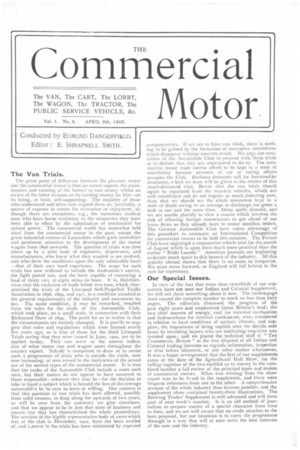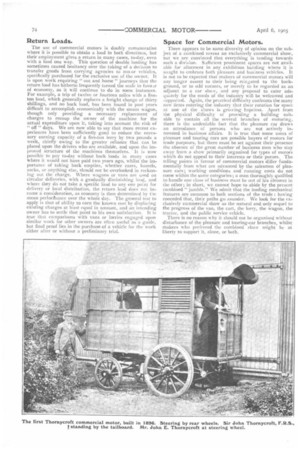The Van Trials.
Page 1

Page 2

If you've noticed an error in this article please click here to report it so we can fix it.
The great point of difference bet wren the pleasure motor and the commercial motor is that an owner expects the maintenance and running of the former to cost money whilst an owner of the latter reckons on its earning money for him—on its being, at least, self-supporting. The majority of those who understand and drive cars regard them as, inevitably, a source of expense in return for recreation or enjoyment, although there are exceptions, e.g., the numerous medical men who have borne testimony to the economies they have been able to effect by the substitution of mechanical for animal power. The commercial world has somewhat held aloof from the commercial motor in the past, except the great industrial centres of Lancashire which gave immediate and persistent attention to the development of the motor wagon from 1896 onwards. The question of trials was then taken up by a joint body of engineers, shipowners, and manufacturers, who knew what they wanted to see evolved, and who drew the conditions upon the only admissible basis —that of their own hard experience. The scope for such trials has now widened to include the tradesman's carrier, the light parcel van, and the lorry capable of conveying a load of thirty cwt. at eight miles an hour. It is, therefore, clear that the exclusion of loads below two tons, which characterised the trials of the Liverpool Self-Propelled Traffic Association in 1898, 1899, and moi, is a condition unsuited to the general requirements of the industry and movement today. The same condition, it may be remarked, resulted from the rules for the trials of the Automobile Club, which took place, on a small scale, in connection with their Richmond Show of 1899. The point for us to realise is that the circumstances are entirely changed. It is puerile to suggest that rules and regulations which were framed nearly five years ago, as is true of those for the third Liverpool Trials seeing that they were issued in June, i9oo, are to be applied to-day. They can serve as the merest indication of what motor van and wagon users throughout the country expect. Nobady is competent to draw or to revise such a programme of trials who is outside the circle, now ever increasing, of men versed in the intricacies of the actual use of the several types of the commercial motor. It is true that the ranks of the Automobile Club include a score such men, but their names do not appear to have occurred to those responsible—whoever they may be—for the decision to take in hand a subject which is beyond the ken of the average automobilist be he ever so keen or willing. Our concern is that this question of van trials has been allowed, possibly from valid reasons, to drag along for upwards of two years, as will be seen from the summary we give elsewhere, and that we appear to be in just that state of haziness and uncertE inty that has characterised the whole proceedings. The services of the highly representative body of users which met at the club in December, 1902, have not been availed of, and iiaerest in the trials has been minimised by repeated postponements. If we are to have van trials, there is nothing to be gained by the formation of successive committees which disappear without concrete result. We urge the cornmittee of the Automobile Club to proceed with these trials or to declare that they are unprepared to do so. The commercial motor trade cannot afford to be kept in a state of uncertainty because pressure of car or racing affairs occupies the Club. Business demands call for businesslike treatment, v hich we trust will be given to the matter of this much-discussed trial. Better that the van trials should again be separated from the heaviest vehicles, which are well established and do not require so much lostering care, than that we should see the whole movement kept in a state of doubt owing to an attempt to discharge too great a task at one and the same time. Delay spells disaster, and we are unable placidly to view a course which involves the risk of allowing foreign constructors to get ahead of our home firms as they already have in motor omnibus orders. The German Automobile Club have taken advantage of this procedure to announce an International Competition for commercial motors to be held this autumn. The French Club have organispd a commercial vehicle trial for the month of August which is upon lines much more practical than the earlier " Poids Lourds." American journals are beginning to devote much space to this branch of the industry. All this activity abroad shows that there is no room to temporise. We must move forward, or England will fall behind in the race for supremacy.
Our Special Issues.
In view of the fact that more than two-thirds of our supporters have not seen our Indian and Colonial Supplement, we will tell diem something about it now. The twelve-page inset caused the complete number to reach no less than forty pages. The editorials discussed the progress of the past eight years and emphasised Great Britain's lead; the two chief sources of energy, coal for external conbustion and hydrocarbons for internal combustion, were considered in relation to local conditions of surface, climate, and supplies; the importance of being explicit over the details sent home by intending buyers who are instituting enquiries was insisted upon ; and we placed the technical staff of "THE COMMERCIAL MOTOR " at the free disposal of all Indian and Colonial trading interests as regards information, inspection or trial before shipment, or any other matter whatsoever. It was a happy arrangement that the first of our supplements came at the date of the Agricultural Hall Show, for the falling together of the two enabled us to convey in the combined number a full review of the principal types and makes of commercial motors. What was missing from the show report was to be feand in the supplement, and there were frequent references from one to the other. A comprehensive account of the whole industry thus became possible, and the supplement alone contained twenty-three illustrations. The Brewing Trades' Supplement is well advanced and will form part of next week's number. It is an old method of journalism to prepare matter of a special character from time to time, and we are well aware that no credit attaches to the bare proposal, but our intention is to carry the programme through in a way that will at once serve the best interests of the user and the industry.
Return Loads.
The use of commercial motors is doubly remunerative where it is possible to obtain a load in both directions, but their employment gives a return in many cases, to-day, even with a load one way. This question of double loading has sometimes caused hesitancy over the taking of a decision to transfer goods from carrying agencies to mo.or vehicles, specifically purchased for the exclusive use of the owner. It is upon work requiring " out and home " journeys that the return load has hitherto frequently turned the scale in favo.ir of economy, as it will continue to do in some instances. For example, a trip of twelve or fourteen miles with a fiveton load, which generally replaces a freight charge of thirty shillings, and no back load, has been found in past years difficult to accomplish economically with the steam wagon, though only providing a necessary replacement of charges to recoup the owner of the machine for the actual expenditure upon it, taking into account the risk of " off " days. We are now able to say that more recent experiences have been sufficiently good to reduce the necessary earning capacity of a five-ton lorry by two pounds a week, chiefly owing to the greater reliance that can be placed upon the drivers who are available, and upon the improved structure of the machines themselves. It is now possible to pay to-day without back loads in many cases where it would not have paid two years ago, whilst the importance of taking back empties, whether cases, barrels, sacks, or anything else, should not be overlooked in reckoning out the charge. Where wagons or vans are used on circular deliveries, with a gradually diminishing load, and where they do not take a specific load to any one po:nt for delivery or local distribution, the return load does not become a consideration, as economy is then determined by the mean perforMance over the whole day. The general test to apply is that of ability to earn the known cost by displacing existing charges at least equal in amount, and an intending owner has to settle that point to his own satisfaction. It is true that comparisons with vans or lorries engaged upon similar work for other owners are often useful as a guide, but final proof lies in the purchase of a vehicle for the work either after or without a preliminary trial.
Space for Commercial Motors.
There appears to be some diversity of opinion on the subject of a combined versus an exclusively commercial show, but we are convinced that everything is tending towards such a division. Sufficient prominent spaces are not available for allotment in any exhibition building where it is sought to embrace both pleasure and bus:ness vehicles. It is not to be expected that makers of commercial motors will any longer assent to their being reiegated to the background, or to odd corners, or merely to be regarded as an adjunct to a car sho,v, and any proposal to cater adequately for the needs of the industry will be welcomed and liupported. Again, the practical difficulty confronts the many new firms entering the industry that their rotation for space at one of the shows is growing hopeless. Apart from the physical difficulty of providing a building suitable to contain all the several branches of motoring, there is the undeniable fact that the pleasure car draws an attendance of persons who arc not actively interested in business affairs. It is true that some users of pleasure and touring cars are possible buyers of motors for trade purposes, but there must be set against their presence the absence of the great number of business men who stay away from a show primarily organised for types of motors which do not appeal to their interests or their purses. The telling points in favour of commercial motors differ fundamentally from what are advanced by the salesmen of pleasure cars; working conditions and running costs do not come within the same categories; a man thoroughly qualified to handle one class of business must be out of his element in the other; in short, we cannot hope to abide by the present combined " jumble." We admit that the leading mechanical features are common to both sections of the trade : having conceded that, their paths go asunder. We look for the ex: elusively commercial show as the natural and only sequel to the progress of the van, the cart, the lorry, the wagon, the tractor, and the public service vehicle.
There is no reason why it should not be organised without disturbance of the pleasure and touring-car branches, whilst makers who preferred the combined show might be at liberty to support it, alone, or both.




















